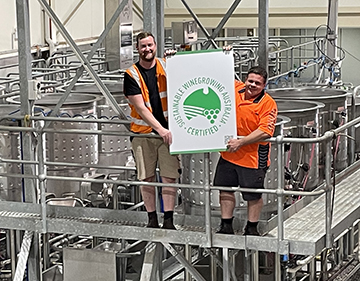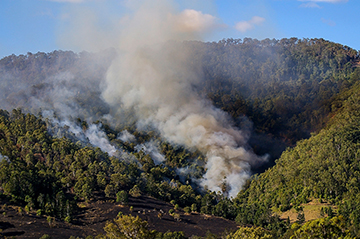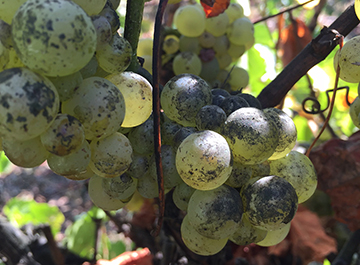Sustainable Winegrowing Australia certification for WIC Winemaking Services
Major grant for no- and low-alcohol production
Smoke background data published
Resources on scale and sooty mould
Latest information on sensors and automation
Sustainable Winegrowing Australia Impact report – coming soon
Order the latest staff publications online
Sustainable Winegrowing Australia certification for WIC Winemaking Services |
|
 |
WIC Winemaking Services, the specialist contract winemaking service operated by the AWRI and the University of Adelaide, has just become a certified member of Sustainable Winegrowing Australia. This certification is testament to work conducted by Winemaker, John Gledhill and Assistant Winemaker, Russell Desmond, to collate all the required sustainability data, undergo training to prepare for certification, be audited and then perform any actions resulting from the audit. The team is proud to be able to demonstrate its sustainability credentials to all its clients. For more information on the services available from WIC Winemaking, contact john.gledhill@awri.com.au.
For other wineries or vineyards interested in certification, attendance at a certification training workshop is the first step. To receive notifications of all upcoming AWRI certification workshops, complete this EOI form. |
Major grant for no- and low-alcohol productionA $4.8 million grant was recently announced by the South Australian Government for the development of a world-leading no- and low-alcohol (NOLO) wine production capability. This funding will enable industry to undertake pilot-scale production of new NOLO products and better understand the market opportunities in this growing consumer segment. The program funded by the grant will be delivered by the AWRI, the University of Adelaide, Wine Australia and Australian Grape & Wine and is structured as four pillars: Pillar 1 – Establishment of a pilot/trial-scale production facility The AWRI will be directly involved in Pillar 1 (led by WIC Winemaking Services) and Pillar 2 (led by Dr Wes Pearson, Dr Simon Nordestgaard and Dr Josh Hixson). For more information, contact enquiries@awri.com.au. |
|
Smoke background data published |
|
 |
When grapes are analysed to assess the risk of smoke exposure, the marker compounds used are a selection of volatile phenols and their glycosides. However, these compounds are also present naturally at trace levels in non-smoke-exposed grapes, which can complicate the interpretation of smoke analysis results. To address this, the AWRI collected data on the trace levels of smoke marker compounds in non-smoke exposed grapes of 12 varieties across Australia over four vintages. The grapes were fermented to wine and the concentrations of marker compounds in the wines were also added to the database. Analytical results for grapes or wine can be compared to the background levels database to determine the likelihood of smoke exposure. This work has recently been published as an open access article in the Australian Journal of Grape and Wine Research. The AWRI is working on expanding the background levels database to 16 varieties and data for additional varieties will be collected this vintage. |
Vintage trials underwayAs vintage 2022 kicks off around Australia, AWRI researchers are also busy setting up this year’s crop of vintage trials, which form an important part of many research projects. Some of the goals of this year’s trials include:
The AWRI thanks all the industry collaborators involved in these and other trials and looks forward to sharing the results. For more information on any of these trials, please contact enquiries@awri.com.au. |
|
Resources on scale and sooty mould |
|
 |
A number of regions across Australia have recently reported issues with scale insects on vines and associated sooty mould on grape bunches. Scale insects are common in Australian vineyards but typically do not cause enough damage to warrant action to control them. In some circumstances, however, the population can reach a threshold where intervention is required to avoid fruit being downgraded or rejected. The AWRI’s page on scale insects and sooty mould provides a range of useful resources, including fact sheets, articles and a webinar detailing a red wine trial conducted in 2017 with sooty-mould-affected grapes. For more information or assistance, contact the AWRI helpdesk on helpdesk@awri.com.au or 08 83136600. |
Latest information on sensors and automationAWRI Senior Engineer, Simon Nordestgaard, has been keeping his finger on the pulse of developments in tank instrumentation and has conducted trials of some of the latest sensors that can help to automate manual processes. He published updates on this work in two recent articles in the Australian & New Zealand Grapegrower and Winemaker, with the first focusing on automated ways to measure ferment density and liquid volume, and the second covering new options for measuring H2S in ferments. This vintage, Simon will be extending this work, focusing on density measurements in red ferments and yeas cultures. |
|
Sustainable Winegrowing Australia Impact report – coming soonSustainable Winegrowing Australia will soon release its first ‘Impact Report’ – summarising data collected by the program to demonstrate how Australian grapegrowers and winemakers are working to continuously improve their sustainability practices. The report will include data for vineyard and winery members across six key focus areas: Land and Soil, Water, Energy, People and Business, Biodiversity and Waste. Members of the program will be emailed a copy of the report first and it will then be made available from http://sustainablewinegrowing.com.au by mid-March. |
|
Order the latest staff publications onlineAccessing the latest AWRI publications is easy. Visit the AWRI Publications web page to:
The AWRI’s most recent publications are listed below. 2263 Mierczynska-Vasilev, A., Vasilev, A., Reilly, T., Bindon, K., Vasilev, K. Fluorescence sensing technology for the rapid detection of haze-forming proteins in white wine. Food Chem. 374: 131770; 2022. 2264 Cruz, F.C.S., Habili, N., Wu, Q., Sagarino, R.B., Randles, J.W. Detection of ‘Candidatus Phytoplasma luffae’ in sponge gourd, bitter gourd, and bamboo from Laguna in Luzon, Philippines. Philipp. Agric. Sci. 104(2): 181-185; 2021. 2265 Barter, S., Siebert, T., Bramley, R., Herderich, M., Krstic, M. Better late than never: the formation of distinctive pepper aromas in cool-climate Shiraz. Wine Vitic. J. 37(1): 35-37; 2022. 2266 Dry, P. Inzolia. Wine Vitic. J. 37(1): p. 68; 2022. 2267 Krstic, M. The Australian Wine Research Institute: Annual Report 2021. Aust. N.Z. Grapegrower Winemaker (695): 88-91; 2021. 2268 Krstic, M.P., Culbert, J.A., Parker, M., Herderich, M.J. Smoke taint and climate change. Reynolds, A.G. (ed.) Managing wine quality. Volume 1: Viticulture and wine quality. 2nd Edition: Cambridge, MA ; Oxford, UK : Woodhead Publishing. (Chapter 17.4): 763-778; 2021. 2269 Nordestgaard, S. Beyond Baumé rounds and tank dips. Aust. N.Z. Grapegrower Winemaker (695): 76-81; 2021. 2270 Schmidt, S., Holdstock, M. Ask the AWRI: Aerating red ferments. Aust. N.Z. Grapegrower Winemaker (695): 53-54; 2021. 2271 Wilkinson, K.L., Ristic, R., McNamara, I., Loveys, B., Jiang, W., Krstic, M. Evaluating the potential for smoke from stubble burning to taint grapes and wine. Molecules 26(24): 7540; 2021. 2272 Espinase Nandorfy, D., Siebert, T., Watson, F., Keast, R., Francis, I.L. Understanding the interactive effects of volatile compounds contributing to ‘stone fruit’ aroma nuances in white wines. Aust. J. Grape Wine Res. doi: 10.1111/ajgw.12540 : 1-15; 2021. 2273 Onetto, C.A., Costello, P.J., Kolouchova, R., Jordans, C., McCarthy, J. Schmidt, S.A. Analysis of transcriptomic response to SO2 by Oenococcus oeni growing in continuous culture. Microbiol. Spectr. 9(2): e01154-21; 2021. 2274 Sawyer, S., Longo, R., Solomon, M., Nicolotti, N., Westmore, H., Merry, A., Gnoinski, G., Ylia, A., Dambergs, R., Kerslake, F. Autolysis and the duration of ageing on lees independently influence the aroma and composition of traditional method sparkling wine. Aust. J. Grape Wine Res. 28(1): 146-159; 2022. 2275 Villarreal, P., Villarroel, C., O’Donnell, S., Agier N., Quintero-Galvis, J., Peña, T., Nespolo, R., Fischer, G., Varela, C., Cubillos, F. Late Pleistocene-dated divergence between South Hemisphere populations of the non-conventional yeast L. cidri. Authorea. DOI: 10.22541/au.164182824.45750907 /v1: 2022. 2276 Cordingley, B. Ask the AWRI: Sacrificial yeast cultures for SO2 reduction. Aust. N.Z. Grapegrower Winemaker (696): 52-53; 2022. 2277 Keast, R., Liem, G., Francis, L., Nandorfy, D. Food files: unravelling the flavour of white wine. Food Aust. 74(1): 30-31; 2022. 2278 Dixon, R. Ask the AWRI: How to tame an unruly canopy. Aust. N.Z. Grapegrower Winemaker (697): 54-57; 2022. 2279 Coulter, A., Baldock, G., Parker, M., Hayasaka, Y., Francis, I.L., Herderich, M. Concentration of smoke marker compounds in non-smoke-exposed grapes and wine in Australia. Aust. J. Grape Wine Res. doi: 10.1111/ajgw.12543 : 1-16; 2022. 2280 Nordestgaard, S. Measuring stinky ferments in situ. Aust. N.Z. Grapegrower Winemaker (697): 62, 64-68, 70-71; 2022. |
|
AcknowledgementsThe AWRI acknowledges support from Australia’s grapegrowers and winemakers through their investment body, Wine Australia, with matching funds from the Australian Government. The AWRI is a member of the Wine Innovation Cluster in Adelaide, South Australia. |
|

